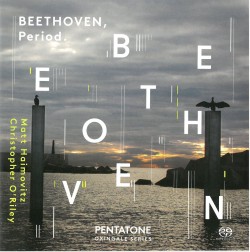 Beethoven, Period
Beethoven, Period
Matt Haimovitz; Christopher O’Riley
Pentatone PTC 5186 475
Beethoven’s interest in the cello appears to have begun early on. His first set of two cello sonatas Op.5 were written in 1796 in his 26th year, his last, Op.102, dates from 1815, by which time the composer was experiencing the trauma of increasing deafness. In between came another sonata and three sets of variations, all of them presented here in this two-disc Pentatone/Oxingale recording featuring cellist Matt Haimovitz and pianist Christopher O’Riley, the first in a series titled Beethoven, Period.
Most cellists choose to perform on early instruments, and Haimovitz is no exception – his cello of choice is a Goffriller, crafted in Venice in 1710. But rather than overpower the cello with a modern concert grand as is sometimes the case with cello/piano pairings, O’Riley proves to be the perfect musical partner in his use of an 1823 Broadwood pianoforte, both instruments tuned slightly below the standard A440. The result is a wonderfully authentic sound, very close to what Beethoven would have heard in the early 19th century
The first CD contains the earliest two sonatas and the 12 Variations on See the Conquering Hero Comes of Handel. From the opening hesitant measures of the Sonata in F Major, we sense the two artists are in full command of the repertoire. Their playing is stylish and precise while the interaction of the two period instruments allows for a compelling degree of transparency.
In disc two, we move into a new period in Beethoven’s style – the Sonatas Op.69 and Op.102 show evidence of a more mature style, somewhat darker and more dramatic, while the seven variations on Bei Männern... from Mozart’s The Magic Flute aptly demonstrate Beethoven’s facility at extemporizing on a popular theme. The “magic moment” for me on this disc came in the second movement Adagio con moto sentimento d’affetto of the Sonata Op.102, No.2. Here Haimovitz’s lyrical tone and the sensitive interpretation by O’Riley evoke a wonderful sense of mystery before the start of the jubilant Allegretto fugato, bringing both the sonata and the set to a most satisfying conclusion.
Bravo to both artists in this exemplary pairing; the “great mogul” himself would have been pleased.



